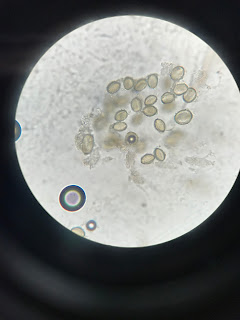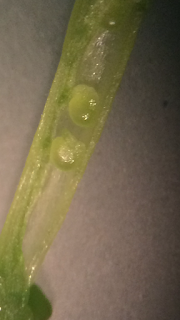In these past few weeks, my group and I have been learning about the reproductive process in Brassica Oleracea plants. First, we researched the functions of all the main, important parts of the flower. The two main reproductive organs are the stamen (male) and pistil (female). On the end of a stamen are the anthers. The anthers are responsible for producing pollen through meiosis. Reproduction can't take place unless pollen travels through the plants. So, the pollen starts to move its way towards the stigma. Here, the pollen sticks onto the stigma. The stigma is the end of the pistil, or the female reproductive organ. Once the pollen reaches the stigma, it's taken through the pistil to the ovary. When it's in the ovary, the pollen germinates the ovules and the reproduction cycle begins.
This is a picture of the flower my partner and I chose from the garden. This is what a brassica flower looks like. Here you can see some of the main parts of the flower including the petals, stigma, anthers and the stamen.
We removed all of the petals on the flower to see the parts clearly. Here's a close picture of the stamen and anthers. The stamen is the green stem which is the male reproductive organ. The anther is the part in which pollen is created during Meiosis. Eventually, the pollen created on the anthers will reach the female reproductive organ and the plant can reproduce. The filament is the long stalk like thing on the male reproductive organ.
Here is a photo of the female reproductive organs. The female parts consist of the pistil. The larger end of the pistil is known as the stigma. The stigma is the sticky part of the stem where the pollen from the stamen sticks onto and gets germinated. This is how the reproductive cycle starts.
After examining the male and female parts, we removed all of the parts until we got to the insides. This small, skinny green bean looking part is the ovary. We sliced open the ovary and inside saw the ovules. The ovules are the unfertilized plants that will eventually start to reproduce. The pollen from the stamen will eventually reach the ovary and start the reproductive cycle.
Extra : We took the anthers and tapped some pollen onto a wet glass slide. We placed it under a compound light microscope and this is a close up view of it.















